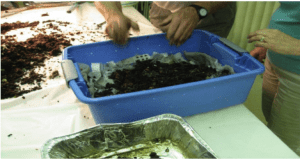Making A Worm Bin (Vermicomposting – Indoor Composting with Worms)
By Dawn Pettinelli, Associate Extension Educator, PSLA. (Written 2014, updated 2025)

Looking for a low-tech way to recycle kitchen scraps while at the same time creating a great soil amendment, right in your own home? If so, vermicomposting, or in layman’s terms, composting with worms might be just the solution you are looking for. The basic premise of vermicomposting is that worms live in a container of moistened, shredded paper bedding into which food wastes are placed. The worms consume both the bedding and the kitchen scraps, and produce nutrient-rich castings that are added to gardens or planting mixes. A well-maintained worm bin should not smell and can recycle at least one pound of food waste for every pound of worms per week.